
AUSTRALIA

AUSTRALIA: A student on a university excursion to Rottnest Island off the coast of Perth found a rare green glass spearhead shaped by one of the island’s former Aboriginal prisoners. Between 1838 and 1931, thousands of Aboriginal men and boys were incarcerated on the island, where many of them died from disease and malnutrition. Spearheads, fabricated from glass or ceramics, were used by the prison population for trade and perhaps to hunt quokkas, small wallaby-like marsupials. —Jason Urbanus
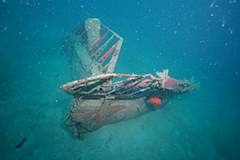
PAPUA NEW GUINEA

PAPUA NEW GUINEA: An organization dedicated to finding missing WWII soldiers and aircraft located two B-25 American bombers that had been lost in the Pacific for more than 70 years. While the existence of one of the planes had been previously known but never scientifically documented, the other was discovered with the help of historical archives, conversations with locals, and extensive surveying of four square miles of seafloor using sonar scanners, high-definition imagers, and underwater robots. —Jason Urbanus
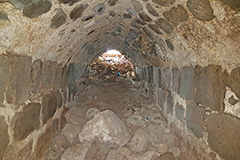
ISRAEL

ISRAEL: Apparently even 800 years ago, Crusader forces were aware of the concept of always leaving yourself a way out of a sticky situation. Conservation and restoration work in the old city of Tiberias exposed a secret escape tunnel that once connected the 12th-century Crusader citadel directly with the harbor on the Sea of Galilee. The surviving 21-foot section may have been used during times of turmoil, especially when the fortress was besieged by the Muslim general Saladin in 1187. —Jason Urbanus
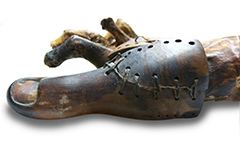
EGYPT

EGYPT: A reexamination of a 3,000-year-old prosthetic toe from Egypt is revealing that it is even more sophisticated than originally thought. The wooden prosthesis was discovered on a female mummy in 1997 in a tomb near ancient Thebes. The artificial toe’s materials and design provided a surprising level of balance and movement, but the object’s creator also strove to make it as aesthetically pleasing and lifelike as possible. Tests have shown that the device was readjusted over time to suit its owner. —Jason Urbanus

ROME

ROME: Modern scientists have long been baffled by the remarkable durability and water-resistant nature of Roman concrete, even after it has been submerged for 2,000 years. Although the exact recipe is lost, the base ingredients of Roman concrete are volcanic ash, lime, and volcanic rock. A new study suggests that when seawater encounters the volcanic material, it causes a chemical reaction that produces a rare crystalline mineral that subsequently reinforces the structure. Therefore, while modern concrete deteriorates quickly in water, Roman concrete actually strengthens over time. —Jason Urbanus

SPAIN

SPAIN: Cats have assumed various roles in human societies: house pets, rodent deterrents, even Internet memes. In Spain, some 1,000 years ago, it appears that they were also exploited for their fur. Analysis of nine cat skeletons from a medieval rubbish pit at the El Bordellet site shows that the skinning process left definitive cut marks on the bones. The cats ranged from 6 to 25 months in age, apparently the optimal age for producing a suitably sized hide but young enough so the fur was unlikely to have been damaged. —Jason Urbanus
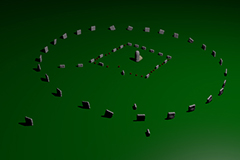
ENGLAND

ENGLAND: Geophysical survey within one of Avebury’s stone circles detected previously unknown evidence of an older standing stone monument, but one whose megaliths were arranged instead in a square. Erected in the 4th millennium B.C., the 10,000-square-foot complex is the first of its kind identified, and may be 1,000 years older than Avebury’s and even neighboring Stonehenge’s stone circles. Researchers believe that the stones may have commemorated a wooden building that was perhaps associated with the original Neolithic settlement. —Jason Urbanus
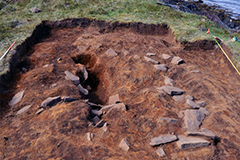
ICELAND

ICELAND: Sometimes modern place names can provide clues about past human activities, as is the case at Dynes along the Eyjafjörður fjord. The term Dynes comes from an old Icelandic word meaning burial mound, and, fittingly, archaeologists recently discovered several Viking Age tombs there, including as many as three rare ship burials. Although the graves were partially destroyed by ocean erosion, one ship contained a Viking chieftain who was entombed alongside his weapons and his dog. —Jason Urbanus
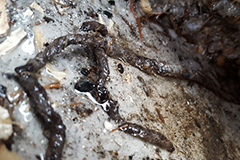
FLORIDA

FLORIDA: Rare 1,000-year-old Calusa Indian artifacts, including pieces of wood, rope, and fishing net, were retrieved from a waterlogged midden located along the ancient shoreline in Pineland. The fishing net, likely fashioned from cabbage palm fiber, has some of its knots still attached. This allowed researchers to determine that its grid is around an inch wide. The deposit also contained clamshell weights and unburned seeds from a gourd-like squash, possibly all that remains of the attached gourds that once enabled the net to float. —Jason Urbanus

LOUISIANA

LOUISIANA: Two people walking along the banks of the Red River in northwest Louisiana discovered a massive Caddo Indian canoe. The 34-foot-long, 2.5-foot-wide, dugout canoe is believed to be between 800 and 1,000 years old and was carved from a single tree trunk. It took a large team of workers using heavy machinery to finally remove the vessel, which may be the largest intact prehistoric watercraft ever found in the United States. —Jason Urbanus










